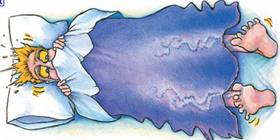Restless Leg Syndrome
What is Restless Leg Syndrome?
This condition is a problem of the leg wherein there is an uncomfortable feeling such as pain the leg area whenever the patient is at rest such as sitting down or even lying in bed. This is a neurological disorder affecting the legs but sometimes, other parts of the body are also affected like the torso or trunk, and the arms.
The RLS is also called as the Willis-Ekbom disease where the patient will associate the discomfort as something that can’t be scratched or a tickle that cannot be stopped. More than that, the restless leg syndrome is intensified when the person is at rest like reading a book, studying and even during sleep.
According to the studies, women have higher tendencies of developing the problem than men. And the symptoms develop gradually peaking when the person is about 50 years old, the symptoms become worse at nighttime causing the, to have an abnormal sleeping pattern.
Picture view to show restless leg syndrome
Symptoms & Signs
With RLS, the problem is diagnosed 10 to 20 years after because at a younger age, the pain is generic and it is not worse. But during middle adulthood, more signs and symptoms are experienced like:
- Unpleasant sensations wherein patients would describe it as either: cramping, creeping, tense, pulling, uncomfortable, itchy, burning, gnawing, aching, tingling and others
- The pain escalades when the patient is resting or about to rest
- Then it worsens during nighttime
- The pain will be relieved if certain movements are done like jogging, walking, pacing, or whatever movements that offers relief
- Twitching of the legs during night time
- Disturbed sleeping pattern
Apart from that, by 2003, the NIH or National Institutes of Health made concise criteria on how to diagnose the problem with the symptoms presented like:
- Activity improvement where patients will find relief if they keep on moving
- Having the urge to move the limbs without sensation or with sensation
- It gets worse while at rest
- Worsening at night disrupting the circadian rhyth
Causes & Risk factors
There are 2 kinds of restless leg syndrome: the primary and secondary restless leg syndrome. In primary RLS, the cause is idiopathic or unknown. In secondary RLS however, there are underlying medical problems that causes the RLS
- Lack of iron or iron deficiency is said to be a cause of RLS. Iron is linked with the problem or at some point, it worsens the RLS
- Peripheral neuropathy. With this problem, the nerves in the arms and legs are damaged causing the lack of oxygen supply in the area then results to painful sensation, numbness and tingling sensation.
- Abnormalities in the neurotransmitters like dopamine are also likely to cause restless leg syndrome. These neurotransmitters help in regulating the muscle contraction or movements.
- Medications may also worsen the RLS like antiemtic drugs, antipsychotic drugs, anticonvulsants, anti-depressants, and even sudden withdrawal of benzodiazepines.
Treatment
As soon as restless leg syndrome is diagnosed, it is important to know the cause of the problem and address it right away. There are medications that can be taken in order to avoid worsening the problems like:
A. Opioids
These are narcotics which should be given at a small dose since it can be addicting. Opioids are analgesics of higher dose that helps relieve the uncomfortable feeling. Some opioids include codeine, oxycodone, etc.
B. Parkinson’s disease medications
The Parkinson’s disease medications are given in patients with RLS because it reduces their extra movements. Parkinson’s disease drugs such as carbidopa and levodopa increases the level of dopamine, one of the neurotransmitters in the brain that also causes the restless leg syndrome. Most of the time, the drug taken by patients with RLS are a combination of carbidopa and levodopa and patients are expected to feel mild side effects like nausea and fatigue.
C. Sleeping pills and muscle relaxants
These are prescribed since RLS has the tendency to disrupt the circarian rhythm which dictates the sleeping pattern of an individual. These drugs include clonazepam, eszopiclone, ramelteon, etc.
D. Epileptic drugs
Sometimes, drugs for epilepsy like gabapentin are prescribed to reduce abnormal twitching for patients with restless leg syndrome.
Home Remedies
Aside from the medications prescribed by the doctor, there are home remedies that need to be done in order to give relief from RLS. These include:
- Massage and warm bath are suggested in order to relax the muscles especially the legs. Aside from massage, there are also other relaxation methods like doing yoga, meditation especially at night before going to bed.
- Pain relievers are also suggested like NSAIDS to address simple discomforts and relieve muscle twitching sensations
- Having warm, clean and good sleep hygiene may promote sleep at night. As much as possible, it is important to have a cool and quite place and a comfortable bed to relax and entice sleep. Having a warm shower is also suggested to have good nights sleep.
- Application of warm and cold packs in alternate is helpful to reduce sensation of the limbs.
- Vices should be cut like drinking alcohol and smoking. These aggravate the symptoms of RLS especially when there is peripheral neuropathy.
- Cutting on caffeine or caffeinated drinks may reduce the restlessness felt by the patient.
